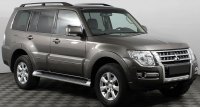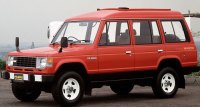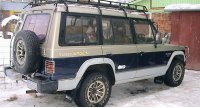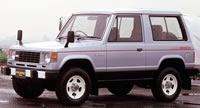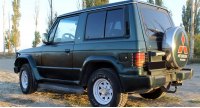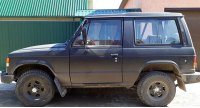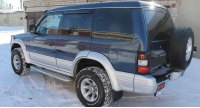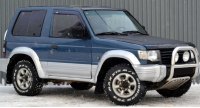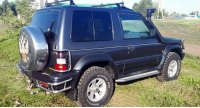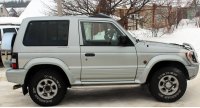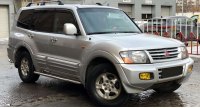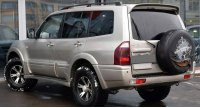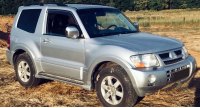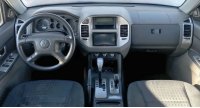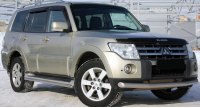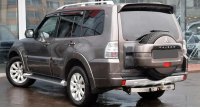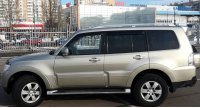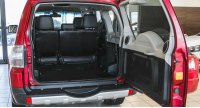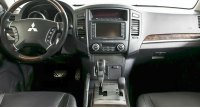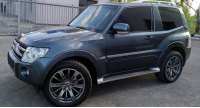Share with friends:
The engine is located in front, the drive is full on all wheels. The body is a three- or five-door SUV with a supporting frame (first two generations). The main classmates and competitors at present are Audi Q7, BMW X6, Chevrolet Suburban, Dodge Durango, Ford Explorer, Infiniti QX80, Jeep Wrangler, Kia Mohave, Lexus GX, Land Rover Range Rover, Mercedes G-Class, Nissan Patrol, Porsche Cayenne, SsangYong Rexton, Suzuki Grand Vitara, Toyota Land Cruiser, UAZ Patriot, Volkswagen Touareg and VAZ-2121.
First generation (L040, 1982-1991)
First prototype «Pajero» was shown at the Tokyo Motor Show in November 1973, and again in 1978, five years later. In the same place, at the Tokyo Motor Show in October 1981, the production version of the car was presented, and sales began in May 1982. It was originally a three-door, short-wheelbase metal or open-top body with an overall length of 3995 mm, a width of 1679 mm and a height of 1849 mm. In February 1983, a five-door model appeared with a long wheelbase and an overall length of 4650 mm, a width of 1692 mm and a height of 1890 mm. This car had three rows of seats and seven seats. In 1991 the company «Hyundai» acquired a license to manufacture «Pajero» and began to produce an SUV «Hyundai Galloper» until 2003. _
Petrol four-cylinder engines had two 2.0-liter models (1997 cm3, 4G63, 110 hp) and 2.6 liters (2555 cm3, 4G54, 103 hp), and there was also one 3.0-liter six-cylinder V-twin engine (2972 cm3, 6G72, 141 hp). There were four options for diesel four-cylinder engines, two atmospheric 2.3-liter (2346 cm3, 4D55, 75 hp) and 2.5 liters (2476 cm3, 4D56, 95 hp), as well as two turbocharged 2.3-liter (2346 cm3, 4D55T, 95 hp) and 2.5 liters (2476 cm3, 4D56T, 99 hp). Transmission 5-speed manual or 4-speed automatic «Aisin».
Second generation (V20, 1991-1999)
In January 1991, the second generation Pajero appeared in Japan, exports to other countries began later. The dimensions of the car have grown a little. The three-door body was 4075 mm long, 1695 mm wide and 1835 mm high. The five-door body had a length of 4655 mm, a width of 1695 mm and a height of 1890 mm. The curb weight was 1875 kg. The body was available in four versions - metal top, open top, semi-high and high roof. Options such as a mechanical winch, adjustable shock absorbers, a hydraulic system to change the clearance, multimode ABS, etc. have become available. New transmission «Super-Select 4WD» (SS4) allows you to switch from rear to all-wheel drive at speeds up to 100 km / h. On the first generation, for this operation, the car must stand still. A differential lock was standard.
There were two 2.4-liter four-cylinder petrol engines (2350 cm3, 4G64, 112 hp) and 2.6 liters (2555 cm3, 4G54, 103 hp). There were also two 3.0-liter six-cylinder V-shaped gasoline engines (2972 cm3, 6G72, 150-181 hp) and 3.5 liters (3497 cm3, 6G74, 194-208 hp). Diesel engines were four-cylinder turbocharged 2.5 liter (2498 cm3, DK4A, 75 hp), 2.5 liters (2476 cm3, 4D56, 105 hp) and 2.8 liters (2835 cm3, 4M40, 125-140 hp). The transmission was a five-speed manual, as well as a four- or five-speed automatic.
In 1998, export models received an update. The fenders are wider, new headlights and foglights, bumpers, grille and side steps have also been changed. The interior trim has also undergone some changes. First generation «Pajero» at the same time it was simultaneously sold as «Hyundai Galloper» in Korea, Europe and other countries.
Third generation (V60, 1999-2006)
The third generation appeared in Japan in August 1999, and the car began to be exported at the end of 2000. The body became load-bearing, that is, the frame became integrated. They abandoned the use of the rear axle, replacing it with a gearbox. The body was still three-door (length 4219 mm, width 1875 mm, height 1844 mm) or five-door (length 4798-4831 mm, width 1877-1900 mm, height 1857-1885 mm), that is, the car has become a little longer, wider and lower than the second generation. The curb weight was 1900-2075 kg. The steering became rack and pinion instead of the recirculating ball system of previous generations. The suspension became spring independent on all wheels.
Gasoline engines were only 3.0-liter V-6s (2972 cm3, 6G72, 173 hp), 3.5 liters (3497 cm3, 6G74, 208 hp) and 3.8 liters (3828 cm3, 6G75, 231 hp). Diesel engines were all four-cylinder turbocharged 2.5-liter (2476 cm3, 4D56, 105 hp), 2.8 liters (2835 cm3, 4M40 140, h.p.) and 3.2 liters (3200 cm3, 4M41, Di-D, 165 hp). Transmission 5-speed manual, 4-speed automatic «INVECS-II» and five-speed automatic «Tiptronic INVECS-II». Transmission «Super Select 4WD II» (SS4-II) included an electronically controlled center differential that automatically redistributed torque between the rear and front wheels.
In 2003, a minor update of the car was carried out.
Fourth generation (V80, 2006-present)
In September 2006, the fourth generation Pajero was presented at the Paris Motor Show. The body was also a shortened three-door (length 4385 mm, width 1875 mm, height 1840 mm) and the usual five-door (length 4900 mm, width 1875 mm, height 1890 mm). The curb weight of a five-door car was 2265-2335 kg. From these figures it is clear that the car has become longer and heavier. In the basic configuration, the front airbags became two-stage, and side airbags and curtain airbags also appeared. All-wheel drive system «Super-Select 4WD II» improved with electronic stability control and brake force distribution. Production was carried out only in Japan.
Gasoline engines were mostly 3.0 liter V-6s (2998 cm3, 6B31, 220 hp), 3.0 liters (2972 cm3, 6G72, 173 hp), 3.5 liters (3497 cm3, 6G74, 220 hp) and 3.8 liters (3828 cm3, 6G75, 250 hp). The Chinese market had a 2.4-liter four-cylinder engine (2350 cm3, 4G64, 112 hp). There were two diesel models, both four-cylinder turbocharged 2.8-liter (2835 cm3, 4M40, TD, 140 hp) and 3.2 liters (3200 cm3, 4M41, Di-D, 200 hp). The gearbox is a five-speed manual, as well as a four- and five-speed automatic.
In the 2010 model year, an acoustic speaker system began to be installed «Rockford» and two interior color options - black and beige. In 2012, the car received a minimal update and received an improved monocoque body and updated suspension. During the 2015 model year, the front of the car was updated with a redesigned grille, LED daytime running lights and a new spare wheel cover. The interior has also been updated.

